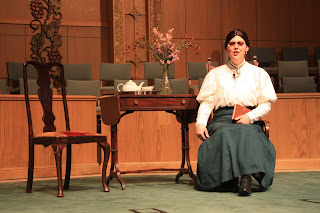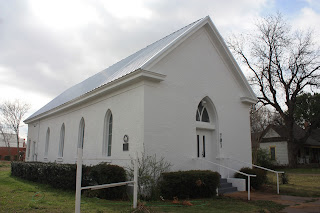"Lone Star Historian" is a blog about the travels and activities of the State Historian of Texas. Bill O'Neal was appointed to a two-year term by Gov. Rick Perry on August 22, 2012, at an impressive ceremony in the State Capitol. Bill is headquartered at Panola College (www.panola.edu) in Carthage, where he has taught since 1970. For more than 20 years Bill conducted the state's first Traveling Texas History class, a three-hour credit course which featured a 2,100-mile itinerary. In 2000 he was awarded a Piper Professorship, and in 2012 he received the Lifetime Achievement Award from the Wild West Historical Association. Bill has published almost 40 books, half about Texas history subjects, and in 2007 he was named Best Living Non-Fiction Writer by True West Magazine.
My first teaching position was in Lampasas, as 8th-grade language arts instructor and coach of junior high football, basketball, and track. During my three years at LJHS, one of my finest student-athletes was Mark Bumpus. Mark was an excellent student and a standout basketball player, as well as a member of my Sunday School class at the First Baptist Church. Today Dr. Bumpus, a graduate of Baylor and the Southwestern Theological Seminary, is pastor of the First Baptist Church of Graham. He has a keen interest in history, and he is a member of the History Commission of the Baptist General Convention of Texas.
 |
| Dr. Bumpus with Bill |




Dr. Bumpus has been pastor at FBC Graham for less than a year. He had hoped to stage a men's night of fellowship and activity, and he asked me to present a Saturday evening program on "Gunfighterology." I pointed out to Mark that I've presented a version of this program for years, but never to a church audience! He laughed and told me he intended to focus on the theme of justice (in conversation he heard me emphasize that a gun is a tool, as good or as bad as the person who uses it). To illustrate the program I use replica pistols, along with different holsters, to demonstrate the evolution of revolvers and gun rigs. Of course, nothing is more dramatic than life and death conflict, and when that conflict takes place in a Western setting, a strong appeal is generated. Mark and his staff had hoped to attract perhaps 30 men, but more than 80 attended. We enjoyed a superb steak dinner, and the men provided a responsive and enthusiastic audience. The next morning I thoroughly enjoyed the worship service, in part because I was greeted by many new friends.

At the evening service my daughter, Dr. Shellie O'Neal, performed her one-woman play about blind hymn composer Fannie J.Crosby. It was Shellie's 30th performance, and I was privileged to escort "Fannie" onto the pulpit/stage area. Shellie's play is a fine piece of musical biography, and her powerful performance moved the congregation.
 |
| 1885 First Baptist Church |

On previous trips to Graham I hardly had ventured away from downtown, but I had more time than usual on this pleasant weekend. I returned to the town square - actually a rectangle, a vast area that is touted as the largest town square in America. Gustavus Graham platted the townsite in 1872, a year after he and his brother Edwin settled in the area. A post office was approved in 1873, and the next year Graham was designated the seat of Young County. In 1879 Dr. J.E. Ryus erected a masonry building on the west side of the square: he operated a drug store on the ground floor, while upstairs was the home of a federal court (until 1896, when the court was transferred to Abilene).
 |
| Museum on the square |
Also on the west side of the square is the National Theater, which has shown movies since 1919. A few doors to the north is the impressive facade of the 1921 Liberty Theater (no longer a theater, but a reminder of the post World War I era when movie theaters often were named "Victory" or "Liberty"). In the middle of the square an excellent museum is housed in the old post office.


Just west of the square is the site where, in 1877, cattlemen plagued by rustlers formed the organization now known as the Texas and Southwestern Cattle Raisers Association. Elsewhere off the square are a number of fine Victorian homes. In 1917 oil was discovered nearby, and the subsequent boom produced fine examples of early 20th-century architecture. All in all, Graham proved to be a good subject for a blog, because on several levels my weekend there proved to be an enjoyable historical experience.




 Dr. Bumpus has been pastor at FBC Graham for less than a year. He had hoped to stage a men's night of fellowship and activity, and he asked me to present a Saturday evening program on "Gunfighterology." I pointed out to Mark that I've presented a version of this program for years, but never to a church audience! He laughed and told me he intended to focus on the theme of justice (in conversation he heard me emphasize that a gun is a tool, as good or as bad as the person who uses it). To illustrate the program I use replica pistols, along with different holsters, to demonstrate the evolution of revolvers and gun rigs. Of course, nothing is more dramatic than life and death conflict, and when that conflict takes place in a Western setting, a strong appeal is generated. Mark and his staff had hoped to attract perhaps 30 men, but more than 80 attended. We enjoyed a superb steak dinner, and the men provided a responsive and enthusiastic audience. The next morning I thoroughly enjoyed the worship service, in part because I was greeted by many new friends.
Dr. Bumpus has been pastor at FBC Graham for less than a year. He had hoped to stage a men's night of fellowship and activity, and he asked me to present a Saturday evening program on "Gunfighterology." I pointed out to Mark that I've presented a version of this program for years, but never to a church audience! He laughed and told me he intended to focus on the theme of justice (in conversation he heard me emphasize that a gun is a tool, as good or as bad as the person who uses it). To illustrate the program I use replica pistols, along with different holsters, to demonstrate the evolution of revolvers and gun rigs. Of course, nothing is more dramatic than life and death conflict, and when that conflict takes place in a Western setting, a strong appeal is generated. Mark and his staff had hoped to attract perhaps 30 men, but more than 80 attended. We enjoyed a superb steak dinner, and the men provided a responsive and enthusiastic audience. The next morning I thoroughly enjoyed the worship service, in part because I was greeted by many new friends.
 On previous trips to Graham I hardly had ventured away from downtown, but I had more time than usual on this pleasant weekend. I returned to the town square - actually a rectangle, a vast area that is touted as the largest town square in America. Gustavus Graham platted the townsite in 1872, a year after he and his brother Edwin settled in the area. A post office was approved in 1873, and the next year Graham was designated the seat of Young County. In 1879 Dr. J.E. Ryus erected a masonry building on the west side of the square: he operated a drug store on the ground floor, while upstairs was the home of a federal court (until 1896, when the court was transferred to Abilene).
On previous trips to Graham I hardly had ventured away from downtown, but I had more time than usual on this pleasant weekend. I returned to the town square - actually a rectangle, a vast area that is touted as the largest town square in America. Gustavus Graham platted the townsite in 1872, a year after he and his brother Edwin settled in the area. A post office was approved in 1873, and the next year Graham was designated the seat of Young County. In 1879 Dr. J.E. Ryus erected a masonry building on the west side of the square: he operated a drug store on the ground floor, while upstairs was the home of a federal court (until 1896, when the court was transferred to Abilene).

 Just west of the square is the site where, in 1877, cattlemen plagued by rustlers formed the organization now known as the Texas and Southwestern Cattle Raisers Association. Elsewhere off the square are a number of fine Victorian homes. In 1917 oil was discovered nearby, and the subsequent boom produced fine examples of early 20th-century architecture. All in all, Graham proved to be a good subject for a blog, because on several levels my weekend there proved to be an enjoyable historical experience.
Just west of the square is the site where, in 1877, cattlemen plagued by rustlers formed the organization now known as the Texas and Southwestern Cattle Raisers Association. Elsewhere off the square are a number of fine Victorian homes. In 1917 oil was discovered nearby, and the subsequent boom produced fine examples of early 20th-century architecture. All in all, Graham proved to be a good subject for a blog, because on several levels my weekend there proved to be an enjoyable historical experience. 
No comments:
Post a Comment